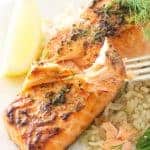Broiled Copper River King Salmon
This vibrant, red-fleshed Broiled Copper River King salmon is rich, succulent and melt-in your mouth delicious! A simple briny soak keeps the flesh firm, moist and beautiful. Serve with basmati rice pilaf, steamed asparagus and your favorite green salad.
Servings: 2 servings
Ingredients
For the Brine:
- Cold water
- Kosher salt
- Brown sugar
For the Salmon:
- 2 Salmon fillets 8-ounce, about 1-inch at the thickest part
- 1 tablespoon butter melted
- 1/2 fresh lemon
- Salt and Pepper
- Fresh dill for garnish
- Lemon wedges
Instructions
- Determine how much water you need to cover the fish, then mix salt, sugar and water in proportions of: 1 tablespoon kosher salt and 1 teaspoon sugar per cup of water. *See Notes
- Place the salmon fillets in a dish in one layer and cover with the brine mixture. Allow it to sit for 10 minutes.
- Removed the salmon fillets from the brine, rinse under cold water and pat them dry.
- Place a cast iron griddle in the oven and preheat the broiler with the oven rack 4 to 6 inches from the heat. *See Notes
- Let the griddle get hot before you cook the salmon.
- Place the fillets, skin side down, on the hot cast iron griddle. Brush each fillet with melted butter and squeeze lemon juice over the tops then sprinkle with salt and pepper.
- Broil 8 to 10 minutes or to the desired degree of doneness. Serve garnished with fresh dill sprigs and lemon wedges
Notes
- Keep fresh salmon in the refrigerator in an air tight container or wrapping until ready to prepare. It is best to eat fresh salmon 3 to 5 days after purchase. It can also be frozen on the day of purchase and kept frozen for up to 3 months. If your product is vacuum sealed, it can last up to 8 months in the freezer.
- Salt is difficult to dissolve in cold water; a quick method is to first remove one cup of the water measurement. Add the salt to a cup of hot water, stir until it dissolves and has cooled. Then add the salty water to the dish with the cold water, creating the brine.
- An easy way to determine the amount of brine to mix is to lay the salmon into a dish, then use a measuring cup to add enough water to cover the fish. Remove the fish and mix the brine: 1 tablespoon kosher salt and 1 teaspoon sugar per cup of water. Stir to dissolve, then add the fillets to the brine.
- Place the top rack of your oven high enough so when you place a heat proof skillet like a cast iron pan with the salmon filets on it there will be 2-inch distance from the heat for every 1/2 inch thickness of salmon. For 1-inch thick fillets they should be 4-inches from the heat. This prevents thicker cuts from overcooking on the outside before the center is completely cooked.
- To determine how long to cook your salmon, rare is 110°F. Medium rare is 120-125°F. Medium is 130°F and well done is 140°F.
- Nutrition information does not include the sugar in the brine. Very little sugar will get absorbed in the meat.
Nutrition
Serving: 1 | Calories: 351kcal | Protein: 44.1g | Fat: 9.8g | Saturated Fat: 5.7g | Cholesterol: 115mg | Sodium: 141mg
